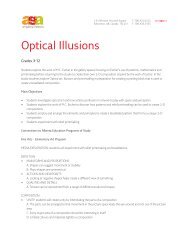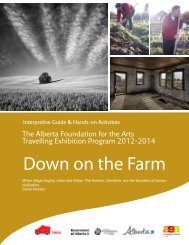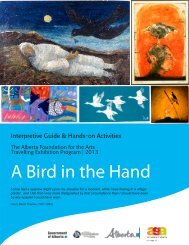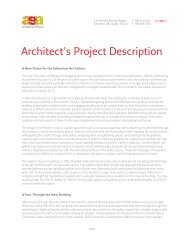Urban Animals - Art Gallery of Alberta
Urban Animals - Art Gallery of Alberta
Urban Animals - Art Gallery of Alberta
Create successful ePaper yourself
Turn your PDF publications into a flip-book with our unique Google optimized e-Paper software.
The <strong>Alberta</strong> Foundation for the <strong>Art</strong>s Travelling Exhibition Program<br />
The History <strong>of</strong> Abstraction: A Survey con’t<br />
For both Kandinsky and Mondrian, abstraction was a search for truths behind<br />
appearances, expressed in a pure visual vocabulary stripped <strong>of</strong> representational<br />
references.<br />
Wassily Kandinsky (1866-1944) was born in Moscow. Originally trained in law and economics,<br />
Kandinsky started painting at the age <strong>of</strong> 30 and, in 1896, moved to Germany to study art<br />
full-time. After a brief return to Russia (1914-1921) Kandinsky returned to Germany where he<br />
taught at the Bauhaus school <strong>of</strong> art and architecture until it was closed by the Nazis in 1933. He<br />
then moved to France where he remained for the rest <strong>of</strong> his life.<br />
Kandinsky’s creation <strong>of</strong> purely abstract work followed a long period <strong>of</strong> development and<br />
maturation <strong>of</strong> theoretical thought based on his personal artistic experience. At first influenced by<br />
both pointillism and the Fauve artists, by 1922 geometrical elements had taken on increasing<br />
importance in his paintings. Kandinsky was also extremely influenced by music as he<br />
considered music abstract by nature as it does not try to represent the exterior world but rather<br />
to express in an immediate way the inner feelings <strong>of</strong> the human soul. He was also influenced by<br />
the theories <strong>of</strong> Theosophy expressed by H.P. Blavatsky. These theories, which had a<br />
tremendous influence on many artists during the 1920s, postulated that creation was a<br />
geometrical progression beginning with a single point. Kandinsky’s mature paintings focus on<br />
geometric forms and the use <strong>of</strong> colour as something autonomous and apart from a visual<br />
description <strong>of</strong> an object or other form and through relinquishing outer appearances he hoped to<br />
more directly communicate feelings to the viewer.<br />
The most radical abstractionist <strong>of</strong> the early<br />
20th century was Piet Mondirian (1872-<br />
1944). Born in Amersfoort, the Netherlands,<br />
Mondrian began his career as a primary<br />
teacher. While teaching he also practiced<br />
painting and these early works, while definitely<br />
representational in nature, show the influence<br />
various artistic movements such as pointillism<br />
and fauvism had on him. Mondrian’s art, like<br />
Kandinsky’s, was also strongly influenced by<br />
the theosophical movement and his work from<br />
1908 to the end <strong>of</strong> his life involved a search for<br />
the spiritual knowledge expressed by<br />
theosophist theory.<br />
Piet Mondrian<br />
Composition with Yellow Patch, 1930<br />
Kunstsammlung Nordrhein-<br />
Westfalen, Dusseldorf<br />
In 1911 Mondrian moved to Paris and came under the influence <strong>of</strong> Picasso’s cubism. While<br />
cubist influences can be seen in his works from 1911 to 1914, however, unlike the Cubists<br />
Mondrian attempted to reconcile his painting with his spiritual pursuits. In this pursuit he began<br />
to simplify elements in his paintings further than the cubists had done until he had developed a<br />
completely non-representational, geometric style. In this work Mondrian did not strive for pure<br />
lyrical emotion as Kandinsky did. Rather, his goal was pure reality defined as equilibrium<br />
achieved through the balance <strong>of</strong> unequal but equivalent oppositions. By 1919 Mondrian began<br />
producing the grid-based paintings for which he became renowned and this subject motivated<br />
his art practice for the rest <strong>of</strong> his life.<br />
AFA Travelling Exhibition Program, Edmonton, AB. Ph: 780.428.3830 Fax: 780.421.0479<br />
youraga.ca

















